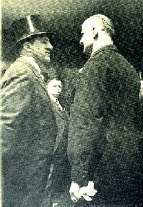|
1 |
 Copyright: Schulze 1986, S. 15 |
|
1 |
 Copyright: Schulze 1986, S. 15 |
Ludwig Mies, who later adopted his mother's surname van de Rohe, was born in Aachen in 1886, the son of a master stonemason. After first working in his father's workshop and with other craftsmen, he moved to Berlin in 1905 to join Bruno Paul. From 1908 onwards he assisted Peter Behrens, together with Le Corbusier and Walter Gropius, before opening his own office in 1912. Originally keeping to the Schinkel architectural tradition, typified by his plans for the Kröller house in The Hague built in 1912, his designs in later years marked the start of a new époque in architecture. His rise to fame as a much respected architect and forerunner of modern 20th century architecture started with his designs for multi-storey glass buildings on triangular sites, such as his entry to the architecture composition for Berlin Friedrichstraße railway station, in 1919.
Eight years after this, Mies van de Rohe built an apartment building for the Weißenhofsiedlung district in Stuttgart, where he was also responsible for the overall co-ordination. During the building of the German Reich pavilion in Barcelona and the Tugendhat house in Brünn, he was at the zenith of his carrier in Europe. From 1930-33 he was director of the Dessau, later Berlin, Bauhaus - the germ of the new architectural trend in Germany. During the national socialist period in Germany, no representatives of the new architectural movement were awarded any contracts.
In 1937 Mies van de Rohe emigrated to the USA to become head of the architecture faculty at the Illinois Institute of Technology in Chicago, the grounds of which he remodelled in 1939/40, and for which he later designed additional buildings. After 1945, Mies van de Rohe's second carrier began in Chicago. Now advanced to the figurehead of the young architectural avant-garde, he played a decisive role in the architecture of the post-war period. In addition to numerous projects in the USA, including administration buildings, museums and residential blocks, between 1965 and 1968 he designed the new national gallery in Berlin which was ultimately completed shortly before his death.
| Year: 1929 | City: Barcelona | Country: Spain |
| Duration: 20 May 1929 - 15 January 1930 | ||